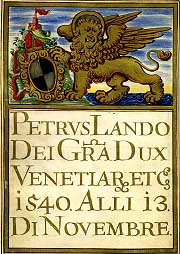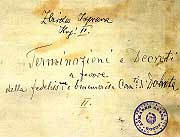Table of Contents
2. Town Autonomies, Marine Municipalities and Village Autonomies
2.1 Town Autonomy
Kotor at the earliest time of the Illyrian (3rd century - 168 B.C.) and the Roman rule (168 B. C. - 476 A. D.) was not the main town in the Bay, called the Bay of Risan at the time (sinus Rhisonicus). Plinie's "Acruvium" from the 1st century A. D. and "Decatera" by a 7th century geographer from Ravenna acquire that supremacy during the long Byzantine rule (476-1185) when the native Roman population, during the colonization by the Slavs and the Avars, were forced to fortify the coastal settlements and energetically turn to, then the only possible, marine trade, thus forming their own strong economical - political and church organisation.
After Byzantine rule, Kotor became a main port of Serbian state during the rule of Nemanići dynasty (1185-1371). At that time, nobel families of Kotor (Buća, Drago, Glavati), kept main financial and trade positions in Serbian state. It was the time when a great number of artists, craftsmen's and workshops were formed in Kotor. The works of this artists can be seen now in Kotor and in Bay of Kotor, as well, as in Montenegro and Serbia (Dečani monastery). Serbian rule mark the first period of Kotors political, economical and cultural rise.
During the rule of Hungarian-Croatian king (1371-1384), Bosnian king Tvrtko (1384-1391) and period when Kotor was a free town-state (1391-1420), instead of big trade conjecture, Kotor fall into great political and economical difficulties, so that the inhabitants of Kotor seek the powerful protection of the Venetians from the advancing of the Turks. During the Venetian rule (1420-1797) starts a new tumultuous period of the development of neighboring coastal settlements, what is of the exceptional economic importance. Various means of autonomy deteriorate to a great degree, but they do not disappear. At the time of the following rules: The first Austrian (1797-1806); Russian (1806-1807); French (1807-1813) and the second Austrian rule (1814-1918), Kotor mainly falls following a steady line of hard decadence.
Legislative Authority
Legislative authority in the Commune of Kotor was being executed through the Great Council (Consilium Maius) consisting of all the noblemen over the age of 18. The Statute of Kotor is the first of the work of the Great Council. Voting was done in three boxes: "de si", "de non", "de non sincero".
Kotor, April 23rd 1629.
 |
The Great Council, in the presence of the other two councils, elect the emissaries to prevent any reduction of the competence of the Minor Council and of the Council of Convinced, in front of the Senate in Venice. SN LXXXV, 557/t - 558 |
Administrative Authority
Administrative authority in the Commune of Kotor was being done through the Minor Council (Consilium Minus), first with the count and 12 members, and from year 1372 with the count and 6 members. The decisions were brought referring to the authorities of the Great Council written in the book of reformations. Sometimes, its sessions ore Held on St. Triphon's square or under the porch of the cathedral. Its service lasts for a year.
Kotor, December 8th 1395.
 |
The count of Kotor, Mihailo Tripunov Buća, with the Minor Council, but in extended number, brings the decisions during the siege of Kotor by Radiča Crnojević. SN II 266, 267 |
The Role of the Council of the Convinced
The Council of the Convinced, consisting of 15 members, has the role of the Senate and deals with important questions, and employs and controls the civil servants in particular.
The Election of a Chemist
Kotor, June 12th 1580.
 |
At the joint session of the Great and Minor Council, with 53 members attending, it was decided that for the town chemist should be elected only such good and experienced pharmacist who will properly keep the chemist's stocked with all the necessary medicines ("tenir la sua bothega in ordine et fornita d'ogni cosa medicinale necessaria"). Under such a duty pharmacist Antonio Saltamacchia was elected (with 25 votes) for the period of two years. SN LXIV, 567 |
The Election of a Doctor
Kotor, July 31st 1591.
 |
At the session of the Great and Minor Council, gathered in the celebration room of the count's place, the provost and the judges suggested doctor Giovanni Lucatello from Feltre to be the town doctor ("dottor m. Zuanne Lucatello de Feltre, fisico") having obtained good information regarding his abilities ("havuta buona informatione de la sufficientia"). He was elected unanimously in both Councils for the period of two years, with the salary of 200 ducats a year. SN LXVI, 963 |
The election of a Teacher
Kotor, April 23rd 1605.
 |
At the session of the Great and Minor council, for the public teacher of the grammar school was reelected the priest Tripun Bolica, the canon of the St. Triphon's cathedral ("il riverendo m. prete Triphon Bolizza per publico precettor digramatica"), since he proved successful for the pleasure of all the town. SN LXIII, 1602 |
Consecration of St. Triphon Cathedral
Kotor, June 19th 1166.
 |
Medieval commune of the Mediterranean type, had regularly the bishopric, patron saint of the faun and the cathedral dedicated to him. After the destruction of an earlier temple from the 9th century, in Kotor was consecrated the new Romanic cathedral of St. Triphon. ("sacravimmus ecclesiam sancti Triphonis") in the presence of 5 bishops, 8 abbots and a Byzantine lieutenant ("dux") for Dalmatian and Doclea. It is not by chance that year of the completion of the cathedral is almost the same as the year of the first document of the maritime past (1167). Where from the means for the monumental construction had come. FOT I, 78 |
The Privileges of Kotor
Venice, April 28th 1421.
 |
The act of the doge Toma Mocenigo, with the title "Privilegium Comunitatis Catari", with the acceptance of 12 requests of the municipality of Kotor. DIL II, 6/1, 6/2 |
Venice, April 29th 1420.
 |
The act of the Toma Mocenigo with the acceptance of the additional requests of the town of Kotor. There is an interesting obligation of the Venetians which says that in case of the cease of the Venetian rule the town should have its freedom returned. The freedom which it had used to have before the taking over of the authority ("... in eadem libertatem cum qua se nostro dominio sommiserunt ..."). That sense of primary freedom and voluntary submission was cherished by the Bokelian Navy by means of taking over the rule of the town for three days DIL I, 5 |
Class relationship
Kotor, October 28th 1711.
 |
The children from the marriages between the nobility and the commoners, could hardly keep the aristocratic prerogatives even then when it concerned respectable families from Perast which were considered to be of "blue blood". The is the example of a nobleman from Kotor Tripo Ivanov Vraćen and his wife from a family from Perast "delle piu honorevoli e principali", where, for the securing of the noble status of their children the voting should take place at the session off the Great and Minor council in the presence of the general provost. SN CXXXII, 824t-825 |
2.2 Marine Municipalites
The privileges were obtained only Through concrete and officially acknowledged merits on the battle field, both on sea, as it was usually the case with the coastal municipalities (especially Perast, Prčanj and Dobrota) and on land, as it was the case with village autonomies. The privileges were realized through certain kinds of political and legal autonomies and through the concessions of economic character. The obligations however, remained both military and economic ones.
Perast
 |
On the basis of the privileges and exceptional efforts Perast achieved the greatest economic and cultural development of all the coastal municipalities of the Bay of Kotor. Its oldest privilege in this collection bound in lather, dates back to November 13th 1540. DIL XII, 109, 109/1 |
Prčanj
 |
Prčanj, the second maritime center kept carefully its privileges, doge's acts and terminations. The earliest document from the collection is from the year 1625. DIL XIII, 139-139e |
 |
"The Green book" of the municipality of Prčanj, with the privileges, approbations and reports during the first and the beginning of the second Austrian rule (1797-1822). DIL XVII |
Dobrota
 |
Dobrota, a prominent maritime center, also kept and made transcripts of the terminations and decrees obtained in its favor. The collection of these transcripts from 1650-1818. has been preserved. DIL XV, 188 |
2.3 Village autonomies
As it can be documented by the archival material of the Historical Archives Kotor , there are four clearly formed village autonomies: Patrovii, Grbalj, Topla and St. Michael's Assembly.
Paštrovići
Kotor, February 6th 1431.
 |
Paštrovići, according to the agreement with the Venetian Republic in the 1426, kept their interior organization, first of all the Assembly and the count. In the Archives Kotor The Assembly of the Paštrovići ("Sborum Pastrovichiorum") is mentioned for the first time in this document. SN V, 17 |
Grbalj
 |
The privileges of Grbalj (1647-1697) ("Privilegi concessi ai popoli della Zuppa"). Certified transcripts on 16 pages. The Venetians considered people's assemblies the sources of evil and rebellions ("... principia mallorum et rebellionis ..."). DIL VII, 147/1 - 147/2t |
Topla
The community of Topla near Herceg-Novi has got a rich documentation in the Archives Herceg-Novi.
Topla, February 14th 1726.
 |
The report of Ivan Burović to the provost, where from it can be seen that the election of the "Captain", as the leader of the local autonomy, was very tumultuous then and that Burović got the impression that through the formation of the village municipality of Topla, in facts was formed the core of the resistance to the Venetian authorities ("... Posso dire e con verita a Vostra Eccellenza che avanti fosse la Comunita s'esigeva da tuti ogni miglior pubblico servitio, ma al presente fanno a loro modo ..."). UP XLIII, 526t-527 |
The St. Michael's Assembly
 |
The privileges of the St. Michael's Assembly from February 9th 1450. The representatives of five villages are Nikola Uglješić and Vule Markov from Luštica, Stijepo Andrić from Krtoli and Tripo Ivov from Bogdašići. DIL XI, 80, 80/1 |